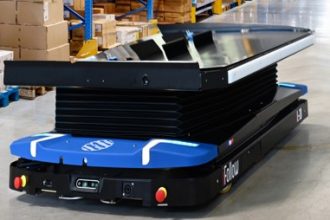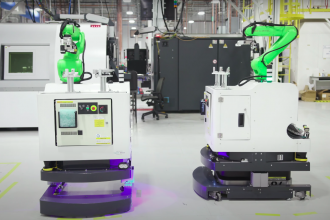AGV & AMR Navigation Systems: Floor-Based vs Lidar

In the rapidly evolving world of mobile automation, navigation is at the core of functionality. Whether it’s an autonomous mobile robot (AMR) or an automated guided vehicle (AGV), how a machine knows where it is and where it’s going is critical.
The Two Main Categories: Floor-Based and Lidar Navigation
Navigation for mobile automation is generally divided into two primary categories: floor-based and Lidar-based navigation.
Floor-based navigation includes methods like magnetic tape, magnetic rods buried beneath epoxy, and magnetic pucks placed at intervals. These are low-cost solutions that require predefined infrastructure. Other technologies like RFID tags, QR codes, and barcodes also fall under this umbrella, functioning similarly to floor-based anchors.
In contrast, Lidar navigation can be either reflector-based or “natural.” Reflector-based systems require the installation of reflective markers in the workspace. The vehicle’s laser scanner uses these markers to confirm its position. Natural Lidar navigation eliminates the need for reflectors by scanning and interpreting the existing environment, making it more flexible in dynamic spaces.
There’s also SLAM (Simultaneous Localization and Mapping), a sophisticated form of Lidar navigation. SLAM uses sensors to build and continuously update a map of the environment while determining the vehicle’s position within it. It can be Lidar-based or use stereoscopic and time-of-flight cameras to achieve similar goals.
Accuracy vs. Flexibility: Pros and Cons of Each Method
Each navigation method has its trade-offs. Floor-based systems are typically easier and faster to deploy, especially in static environments. However, they require ongoing maintenance and are vulnerable to changes in the floor’s condition or layout.
Lidar systems offer higher accuracy and flexibility, particularly in dynamic or complex environments. Natural contour Lidar can achieve accuracy levels below 10 mm and offers superior safety by enabling object detection. However, they come with higher upfront costs and potential challenges in environments with dust, glass, or reflective surfaces.
Environmental factors play a huge role in determining which system to use. Dust, condensation, and uneven floors can interfere with both Lidar and floor-based technologies. Cameras aimed at the floor are less impacted by airborne particles, while Lidar may require regular cleaning or environmental hardening, such as the use of compressed air to maintain clear optics.
Industry Applications and Hybrid Systems
The choice between floor-based and Lidar navigation often depends more on the application than the industry. For instance, grocery stores and hospitals may opt for low-cost, camera-based systems, while large industrial facilities with open layouts and heavy machinery may favor floor-based navigation due to its simplicity and reliability.
Interestingly, hybrid systems are becoming more common. These systems switch between methods depending on the task or location. A robot might use Lidar for general navigation and then switch to a floor-based system for high-precision docking or charging.
Beyond Hardware: The Role of AI and Software
While navigation hardware is foundational, software is playing an increasingly important role. AI and machine learning are being leveraged to improve path planning, object avoidance, and adaptive routing in real-time. This is particularly useful in environments with frequent changes, like moving pallets or unpredictable human traffic.
Although object avoidance is not a new concept, its adoption in industries like heavy manufacturing is still emerging. Integrating AI for route optimization and real-time adjustments is becoming a game-changer, especially for AMRs.
AMRs vs. AGVs: Are the Lines Blurring?
There was consensus among the experts that while AMRs and AGVs have traditionally been treated as separate technologies, the boundaries are becoming less clear. Most navigation systems, except fixed-path options like magnetic tape, can be adapted for both. Barcode grids and SLAM are especially versatile, making them suitable for a broad range of vehicles.
Advice for Practitioners
So, what should end-users and integrators consider when selecting a navigation system?
- Evaluate the Environment: Consider not only the physical space but also temperature, dust levels, floor quality, and lighting conditions.
- Match the Technology to the Task: Understand whether your application requires high precision, flexibility, or cost-efficiency.
- Plan for Lifecycle Maintenance: Opt for systems that are easy to maintain and integrate with existing infrastructure.
- Consult with Experts: Talk to vendors, engineers, and those with relevant experience to understand what works in similar conditions.
- Think Modular and Open-Source: Avoid being locked into proprietary systems that are hard to upgrade or integrate with third-party solutions.
The Road Ahead
The future of navigation in mobile automation lies in sensor fusion, AI-enhanced decision-making, and modular integration. As environments become more dynamic and user expectations for efficiency and accuracy rise, the importance of selecting the right navigation system becomes ever more critical.
In summary, the ideal navigation solution isn’t one-size-fits-all—it’s highly contextual. From dusty warehouses to polished hospital floors, understanding the interplay of hardware, software, and environment is key to building effective mobile automation systems.
Information provided by Align Productions and SICK Sensor Intelligence
To find out more about MHI’s MAG Industry Group: https://www.mhi.org/mag
For further articles/podcasts from MAG:
Maximizing ROI with Mobile Automation: What the Data Shows
Flexibility vs. Predictability in Mobile Automation: What Facilities Should Really Be Considering
Enhancing Safety and Ergonomics Through Automation
Good Fences Make Good Neighbors – Why to Consider Fencing with your Warehouse AMRs
Lessons Learned from Implementing Mobile Automation
The Evolution of AGVs and AMRs
Common Misconceptions with Mobile Robotics



